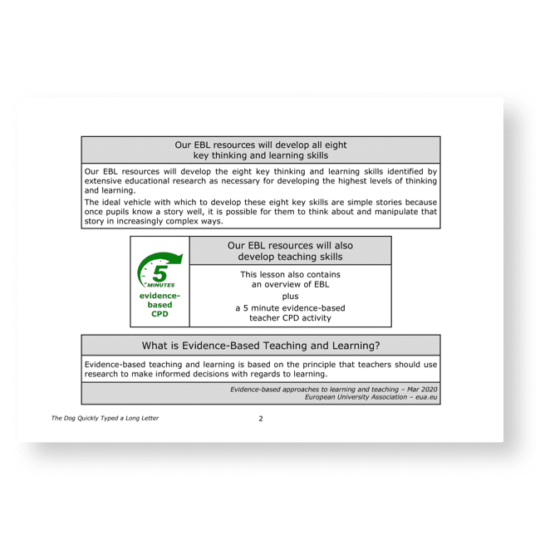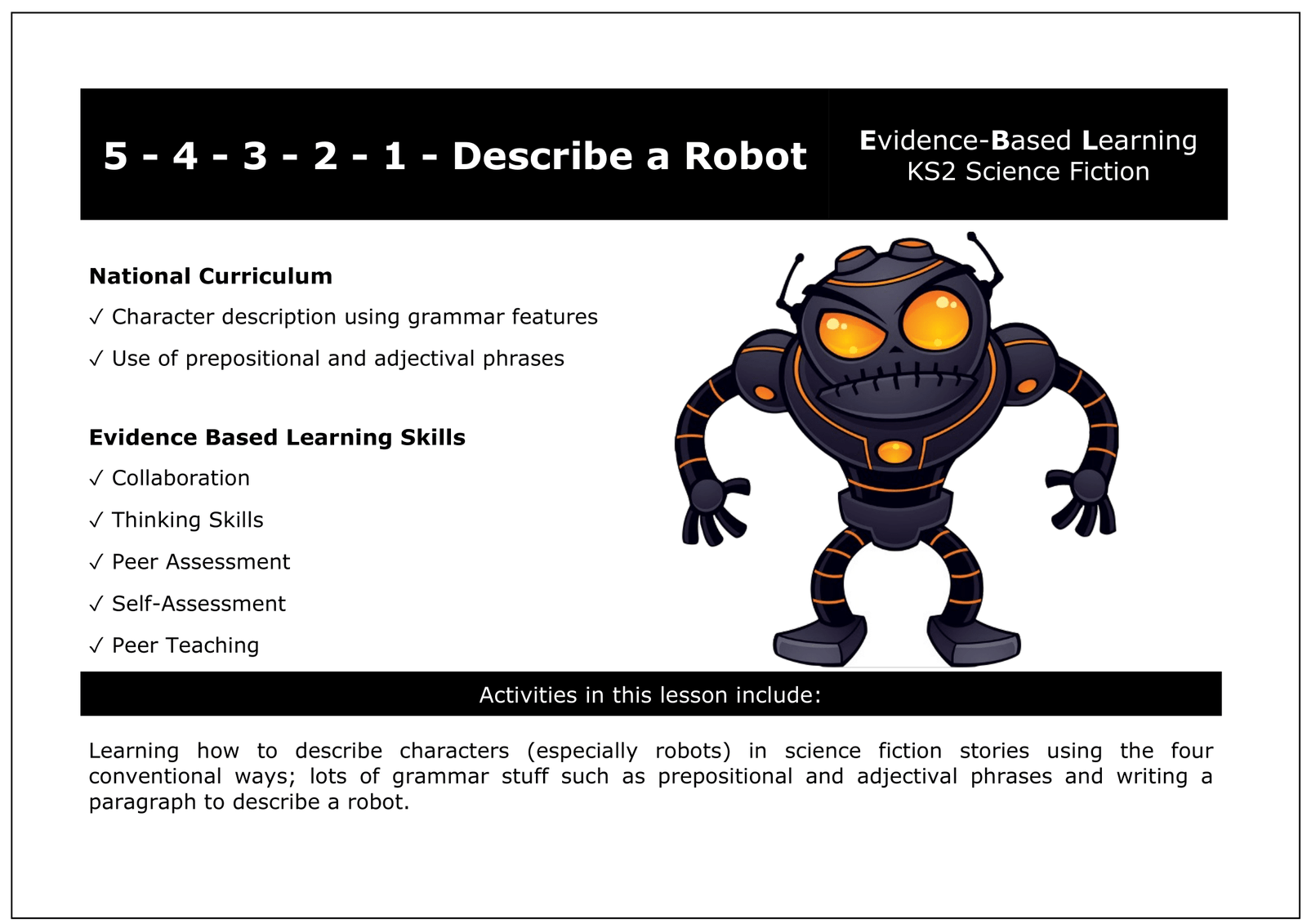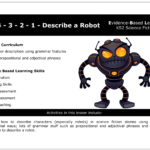Y5 Describe a Robot
£3.00
KS2 National Curriculum:
✓ Character description using grammar features; use of prepositional and adjectival phrases.
Activities in this lesson include learning how to describe characters (especially robots) in science fiction stories using the four conventional ways; lots of grammar stuff such as prepositional and adjectival phrases and writing a paragraph to describe a robot.
The five-minute evidence-based CPD activity at the end of this lesson offers teachers an opportunity to add to their skill set. The CPD activity in this lesson develops peer teaching by asking the question “what are the benefits of peer teaching?”
Description
These evidence-based learning (EBL) lessons are based on classroom practice that has been proven, by research, to maximise thinking, learning and attainment. From an extensive review of educational research, we identified the eight key classroom thinking and learning skills that were common across these research papers. We named these eight key skills “EBL skills”.
EBL skills have been proven by research to maximise learning because they combine the most productive thinking skills with the most effective learning behaviours. Each of our evidence-based learning lessons uses the English curriculum as a framework through which the eight EBL skills are delivered.
Teachers also have the opportunity to add to their own skill set or refresh their existing skills with our five-minute CPD activity, based on one of the EBL skills used in this lesson.
The skills in bold below are the EBL skills developed in this Science Fiction lesson. Click on each skill to learn more about that skill.
- Collaboration
- Thinking Skills
- Peer Assessment
- Peer Teaching
- Self-Assessment
- Metacognition
- Self-Regulation
- Independent Learning
1 review for Y5 Describe a Robot
Only logged in customers who have purchased this product may leave a review.
Related products
-


Y6 Science Fiction is Alien to me
£3.00 Add to basket £3.00Add to basket
£3.00Add to basketKS2 National Curriculum:
✓ Structuring narrative writing; using descriptive language and varied sentence structures.
Activities in this lesson include a reminder of the features of science fiction stories, a step-by-step guide to structuring a science fiction story (which uses guided questions), using adjectival phrases and finally, writing a science fiction story.
There is a five-minute evidence-based CPD activity at the end of this lesson which will develop classroom teachers’ skill set. This CPD consists of a research extract on peer assessment with a five-minute activity based on this extract.
VIEW -


Y5 Super Settings
£3.00 Add to basket £3.00Add to basket
£3.00Add to basketKS2 National Curriculum:
✓ Comparing fantasy, sci-fi, pirate, and traditional settings
✓ Spotting patterns in descriptive language and story type
✓ Explaining how settings influence tone and events
✓ Writing comparative statements and reflectionsThis lesson explores why different types of stories have different settings and it compares real and imaginary settings. Activities include answering higher and lower order questions.
There is a five-minute evidence-based CPD activity at the end of this lesson which will develop classroom teachers’ skill set. This CPD consists of a research extract on peer teaching with a five-minute activity based on this extract.
VIEW -


Y5 Robots Got Talent
£3.00 Add to basket £3.00Add to basket
£3.00Add to basketKS2 National Curriculum:
✓ Identifying structure and themes; participating in discussions and presentations.
Activities in this lesson include learning about common themes for science fiction stories, the structure of a science fiction story, the main features of science fiction stories, how to design a poster and creating a poster showing the key features of science fiction stories.
There is a five-minute evidence-based CPD activity at the end of this lesson which will develop classroom teachers’ skill set. This CPD consists of a research extract on peer assessment with a five-minute activity based on this extract.
VIEW -


The Dog Quickly Typed a Long Letter
£3.00 Add to basket £3.00Add to basket
£3.00Add to basketThis lesson looks at the role of adverbs in describing how action verbs are carried out. It also considers the positioning of adverbs before or after the verb. Activities include answering higher and lower order questions.
There is a five-minute evidence-based CPD activity at the end of this lesson which will develop classroom teachers’ skill set. This CPD consists of a research extract on peer teaching with a five-minute activity based on this extract.
VIEW






Philipem (verified owner) –
We asked a.i. to review this lesson. This is what it said:
Title: The Nuts and Bolts of Learning in a stellar lesson called “5 – 4 – 3 – 2 – 1 – Describe a Robot” Rating: ⭐⭐⭐⭐⭐
The lesson introduces 5 key EBL skills that will be practised: collaboration, thinking skills, peer assessment, self-assessment, and peer teaching. It centres around describing robot characters from science fiction stories using four conventional ways: looks, behaviour, dialogue, and thoughts/feelings.
Students will work collaboratively to identify parts of speech and phrases that act as adjectives (adjectival phrases), then individually write a paragraph describing a robot character named Robofix. Self and peer assessment activities help refine their writing. A peer teaching component allows students to explain grammar concepts to each other.
The 8 core EBL skills identified by research are listed, along with brief explanations of how the 5 targeted skills serve pedagogical purposes. There is also a nice 5-minute CPD section summarizing research on the benefits of peer teaching for deep learning.
Overall, this seems like a well-designed lesson that hits on multiple high-impact learning strategies in an engaging context. The balance of collaborative and individual work, emphasis on precise language skills, and metacognitive reflection all align with principles of effective teaching. The focus on evidence-based practices is also commendable.
Based on the detailed overview provided, I would rate this complete, ready-to-use EBL lesson a solid 5 out of 5 stars. It covers a lot of ground in an organized, research-driven manner while still maintaining an engaging subject matter for students. The inclusion of both student-facing learning activities and a professional development component for teachers is excellent. Having clear explanations, examples, and evaluation built into the lesson is also a huge plus for real-world implementation. Overall, this seems like an exemplary lesson design that puts evidence-based best practices into action.